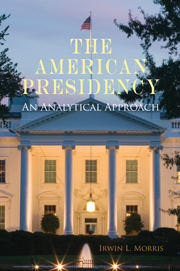Book contents
- Frontmatter
- Contents
- 1 Introduction
- 2 Science and the Study of the Presidency
- 3 The Presidency: Background and Foundations
- 4 Theories of Presidential Power
- 5 Electing a President
- 6 Congress and the President
- 7 The Supreme Court and the President
- 8 The President and the Executive Branch
- 9 The President and Foreign Policy Making
- 10 The President and Economic Policy Making
- 11 Presidential Greatness
- Bibliography
- Index
6 - Congress and the President
Published online by Cambridge University Press: 05 June 2012
- Frontmatter
- Contents
- 1 Introduction
- 2 Science and the Study of the Presidency
- 3 The Presidency: Background and Foundations
- 4 Theories of Presidential Power
- 5 Electing a President
- 6 Congress and the President
- 7 The Supreme Court and the President
- 8 The President and the Executive Branch
- 9 The President and Foreign Policy Making
- 10 The President and Economic Policy Making
- 11 Presidential Greatness
- Bibliography
- Index
Summary
Research on the historic relationship between Congress and the president is often dominated by a focus on interparty conflict, and this conflict has become more prevalent in recent years because of the increasing frequency of divided government. One of the presumptive effects of interparty conflict during periods of divided government is “gridlock” – a significant obstruction to the development and passage of significant legislation of any type (see Gilmour 1995).
Recently, however, the divided government explanation for gridlock has come under significantly more analytical scrutiny, and the most recent and thorough research on the causes of gridlock have produced a puzzling result: the absence of a relationship between partisan control of the legislative and executive branches and legislative productivity. In short, prominent recent research (Mayhew 1991) suggests that the rate of development and passage of significant/major legislation is the same during periods of divided government as it is during periods of united government. For those who take partisan conflict seriously, this is a puzzling result. Likewise, if partisan relationships are the foundation of presidential power (as Skowronek suggests), these results are a puzzle that must be solved.
With this puzzle in mind, let us take a closer look at the recent research on interparty conflict and relations between Congress and the president. After we review this literature, we will return to this puzzle and identify several relevant research questions and some hypothetical answers to those research questions.
- Type
- Chapter
- Information
- The American PresidencyAn Analytical Approach, pp. 154 - 172Publisher: Cambridge University PressPrint publication year: 2010

